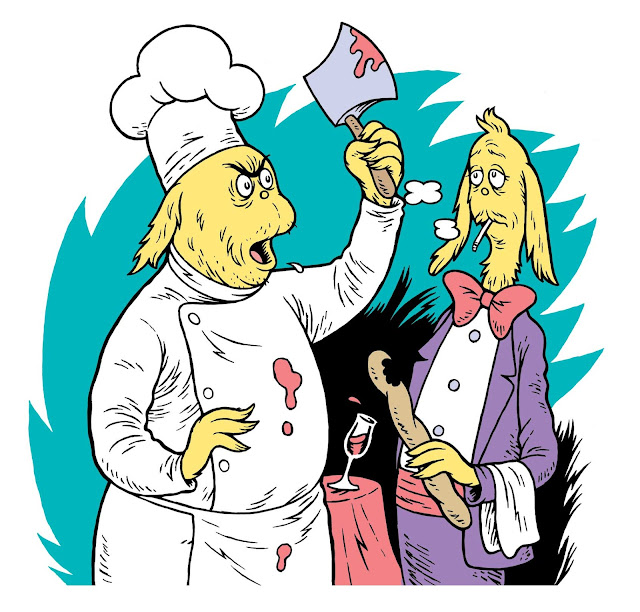Here’s the second batch of illos from last Summer’s killed Dr Seuss parody book project, the saga of which can be read here.
Cartoonist Darren Gendron brought my attention to a successful legal action by the Geisel estate against Penguin Books in 1997. It seems that, at the height of the OJ Simpson trial, the folks at Penguin were moving forward with a Dr Seuss-style parody of the OJ case, written in anapestic tetrameter, with Seuss-style illos and the divinely inspired title, “The Cat NOT In The Hat.”
After reading about the case, I find it hard to decide whose side I’m on. It’s pretty obvious that “The Cat NOT In The Hat” was going to be a TERRIBLE book, and the world is probably an infinitesimally better place thanks to the swift action of the Geisel estate’s attorneys. That said, I can’t see how a book featuring drawings of OJ Simpson wearing a red & white striped hat could ever be confused with the genuine works of Dr Seuss.
As far as I can tell, Penguin wasn’t appropriating Seuss’ trademarked characters for profit, (as Dan O’Neill and the infamous Air Pirates did with Disney’s characters in 1971), and I can’t imagine anyone stupid enough to accidentally hand their child Penguin’s OJ parody book in place of the actual “The Cat In The Hat.” So, why did the judge side with the Geisel estate?
The Plaintiff’s complaint cites an interesting opinion by SCOTUS justice David Souter in Acuff v. Rose: “For the purposes of copyright law, the nub of the definitions, and the heart of any parodist’s claim to quote from existing material, is the use of some elements of a prior author’s composition to create a new one that, at least in part, comments on that authors works…. If, on the contrary, the commentary has no critical bearing on the substance or style of the original composition, which the alleged infringe merely uses to get attention or to avoid the drudgery in working up something fresh, the claim to fairness in borrowing from another’s work diminishes accordingly (if it does not vanish), and other factors, like the extent of its commerciality, loom larger.”
In other words, it’s not parody, (i.e. protected speech) if you’re merely borrowing elements of the original work to get attention and save yourself the drudgery of coming up with something new. But then, doesn’t the use of Seuss’s gimmicks, (the striped hat, the drawing style, the rhyming pattern) juxtaposed with the horror of the Simpson case add up to some kind of commentary on Seuss’s work, and beyond that, is it even possible to create new work that doesn’t draw on existing material? Isn’t new art always, (to some degree) a synthesis of what came before?
My verdict: bad book shut down by worse decision.
More info about the Seuss v. Penguin action here.


















